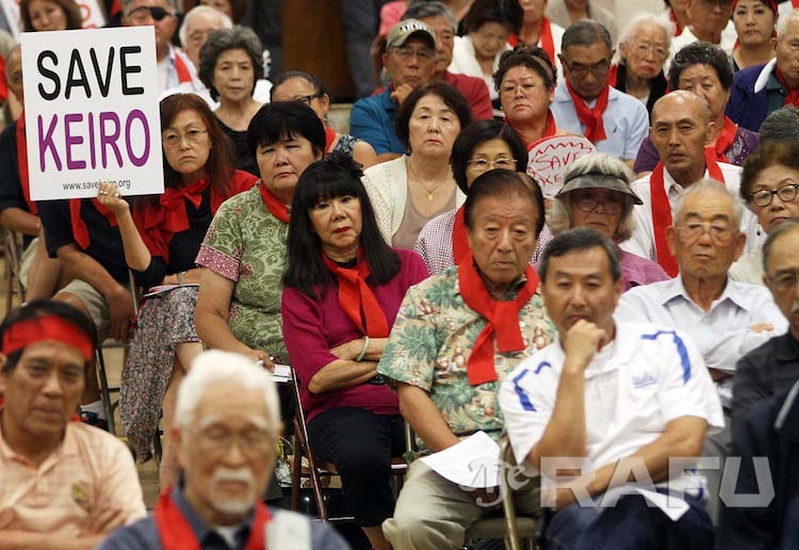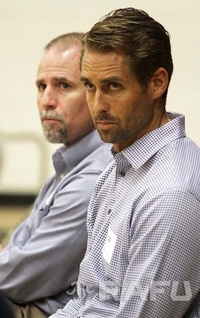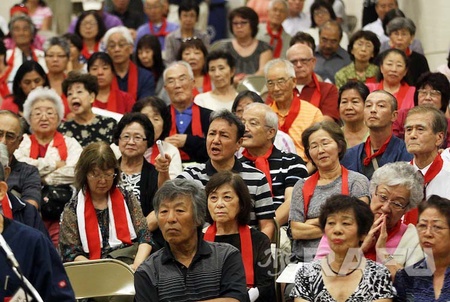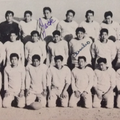Each July during Obon, Japanese Americans gather in the Nishi Hongwanji Temple gym to buy udon. Under the basketball hoops, they slurp noodles out of Styrofoam bowls before wandering back into the cooling night to dance Obon odori, pacing ovals in the parking lot, waving uchiwa, those round paper fans with the plastic skeletons that you can find, any time of year, in Japanese American houses and in the pockets of car doors.
Thursday night, around 400 people packed into the temple gym, mostly elderly, mostly wearing red—red shirts, red scarves, red hachimaki tied, warlike, around foreheads. The crowd filled the chairs and spilled out into the back and wings of the gym, holding signs and uchiwa—not used for dancing now, but for protest. In red marker, in all capital letters, they said, “SAVE KEIRO.”
Many in the Japanese American community, led by a protest group, the Ad Hoc Committee to Save Keiro, had been demanding an open meeting like this one for weeks, and Keiro Senior HealthCare had finally obliged. Even after the meeting started, people continued to come in through the gym doors, and the audience strained to hear the speakers over the squeaks and bangs of folding chairs being wheeled out on metal trollies across the wooden floor.
* * * * *
Keiro Senior HealthCare first announced its intention to sell its facilities—two nursing homes, a retirement home, and an intermediate care facility (ICF)—in early 2014. Because Keiro is a nonprofit, before any sale could go through, California State Attorney General Kamala Harris would have to find it “in the community’s best interest.” In fact, when Keiro found its first potential buyer, Ensign Group in fall of 2014, Harris vetoed that sale. Keiro continued its search for a buyer, eventually finding San Diego-based real-estate developer Pacifica Companies, and on September 2, they received a conditional approval from Harris.
The approval came with twelve conditions altogether, the overall gist of which was that Pacifica must keep operations (including Japanese-focused care and acceptance of Medicare and Medi-Cal) the same for the next five years. Rent costs would be frozen for one year. These concrete conditions, and especially their time limits, brought more of a sense of urgency to the pending sale. Keiro residents, doctors, and other concerned citizens wanted to know what would happen at the end of the one- and five-year conditional periods. Would rents become prohibitively high? Would Medicare and Medi-Cal patients (which make up around 66% of Keiro’s nursing home and ICF population) be asked to pay market rates or leave? Would the Japanese-tailored care disappear—not only the NHK programming and the comfort food, but also the Japanese-speaking staff and volunteers?
Suddenly, the protest group, which began September 9 with activist Mo Nishida and three followers (“It really felt like Momotaro’s adventure: we were the pheasant, the dog, and the monkey that followed Mo, and we didn’t even have kibi dango,” said Little Tokyo psychologist Dr. Keiko Ikeda) grew to 10 people, then 25. Now, the core group is even larger than that, and has gathered signatures of supporters, which numbered almost 2,000 as of Tuesday’s count.
* * * * *
Now, finally, the community had a chance to have a conversation with Keiro in person, and in the Nishi gym, the PA system was failing. Representatives from Keiro, Pacifica, and Aspen (the future operators of the nursing homes and ICF) sat in a row at the front of the room, their blues and blacks in contrast with the audience’s reds. Pacifica and Aspen representatives, Tyler Verdieck and Ryan Case, appeared to be the only two white people in the room, and they sat with their hands in their laps, faces looking humble and nervous. “It’s a little intimidating, to be honest,” said Case to The Rafu after the meeting, when asked how he felt about inheriting such a conflict. Miyake and Keiro chair of the board, Gary Kawaguchi, remained expressionless.
As Kawaguchi read his opening statement, his microphone popped and hissed. The crowd looked around and whispered amongst themselves. Miyake approached the microphone next, and during his statement, its crackling grew louder and more frequent. When he paused, to give tech support time to fiddle with the wires, the silence of the equipment gave way to the low, angry buzz of the crowd. A woman’s voice said the word “conspiracy.”
Helen Funai Erickson, a member of the Ad Hoc Committee and the 1963 Nisei Week Queen, approached the front of the auditorium. “Excuse me, but the people have questions,” she said to the panel. “When will they be able to speak?”
The Ad Hoc Committee had hoped it would be able to share control of the meeting with Keiro, but Keiro was adamant about sticking to its established process. Audience members were asked to write any questions on slips of paper in advance and wait until the panel had finished its presentation before they were allowed to speak. At a meeting scheduled to run from 6 to 8 p.m., Keiro, Aspen, and Pacifica representatives spoke until past 7 p.m., plus responses to audience questions.
Miyake reviewed the board’s decision to sell its facilities. With the Affordable Care Act, patients are increasingly pushed into HMOs, he said, which reduces the chance that they will be able to live at Keiro, even if it were their first choice. At the same time, the demographics of the Japanese American community are changing, as interracial marriages and mixed-race people become more common.
As Miyake spoke, Erickson escorted elderly audience members to the few available chairs. One of them was Frank Omatsu, the last living founder of Keiro, now in his nineties and using a cane to support his tall frame. Erickson brought Omatsu to the front row, where they paused in the aisle as people moved to make space for him.
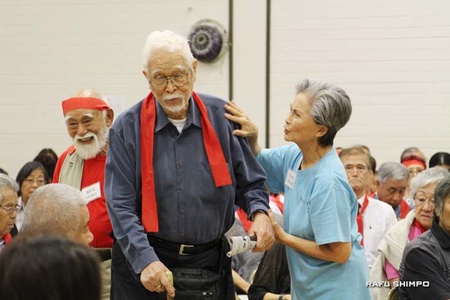
Miyake went on to read all 12 of the attorney general’s conditions, pausing after each one as Keiro’s hired interpreter translated into Japanese. As the crowd felt its time for questions slipping away, people began to boo.
“That’s fine, thank you very much for your opinion,” said Miyake, and later, “A little maturity, please.”
In an email to the Ad Hoc Committee after the meeting, committee member David Watanabe wrote, “Most of the people know the issue, so no rehashing was necessary. 90% of the time should have been allotted to questions from the audience. And asking people to write down the questions, which will be answered later, is so silly. Can’t they face the community head on?”
Aspen and Pacifica representatives spoke next. “What’s important for us is that the transition goes as smoothly as possible for residents, family members, and your wonderful volunteers,” said Verdieck of Pacifica, who looked to be about half the age of most audience members, with striped socks sticking out of patent leather loafers, and pronounced Keiro “kero,” like the cry of a Japanese frog. “We’re here to listen to what’s important to you.” Verdieck received the first applause of the night, not entirely enthusiastic but polite.
Ryan Case, from Aspen, pronounced Keiro perfectly. “It was an easy decision for us to want to be involved with you folks,” he said. “I’ve been involved with many transitions. What’s most important is that you change nothing.”
“Hontou?” shouted a Japanese voice from the crowd. The interpreter translated.
“Really,” answered Case. “I see signs out there that say ‘Save Keiro.’ I’d like to do the same thing. We will work hard and would like to ask you for an opportunity to earn your trust. In no way do we want to create a situation where we are on opposite sides with you folks.” He assured the crowd that all Aspen facilities accept Medicare and Medi-Cal, and that they would continue to do so with these facilities, even once the conditional five years end.
At 7:15 p.m., emcee Tim Manaka called the first audience member, Dr. Takeshi Matsumoto, to the microphone. As he has at all Ad Hoc Committee meetings in the past, Matsumoto wore a pair of blue scrubs, this time with a red ribbon pinned to his shirt pocket and a professionally printed “Save Keiro” sign.
“The problem I have is, why can’t you transform Keiro to accommodate these changes?” he said. He cited other possibilities for Keiro besides selling, such as following the model of Hollenbeck Palms, a neighboring senior home that is surviving as a nonprofit, or contracting with third-party nursing and retirement home operators as Pacifica will do with Aspen and Northstar (the latter not represented at Thursday’s meeting). Several times during Matsumoto’s speech, Manaka attempted to cut him off and usher him away from the microphone, but the crowd reacted by booing and shouting, “Let him speak!” When Manaka and Keiro finally insisted that his time was up, Matsumoto shrugged, holding his “Save Keiro” sign over his head as he walked back into the audience.
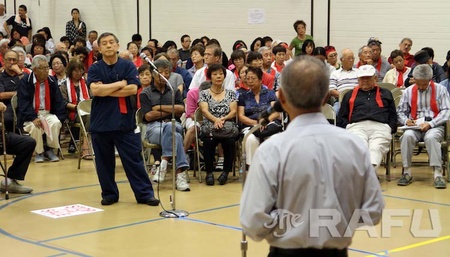
Miyake answered Matsumoto’s questions by saying that Hollenbeck Park survives by keeping its rates high and having minimum asset requirements for all residents. It also does not provide all the services of a skilled-nursing facility. As for contracting with third parties, he argued that Keiro donors wouldn’t want to support an organization that didn’t run its own facilities. By selling the facilities to a bigger company better equipped to handle healthcare and demographic changes, he said, Keiro could continue to honor its mission of taking care of the Japanese community’s seniors.
Dr. Kenji Irie, another Ad Hoc Committee member, spoke next, giving a prepared speech in both English and Japanese. “I want to make a comment to Mr. Miyake,” he said, turning around to wave at the panel. “Hi, Mr. Miyake.”
Miyake, leaning on his elbow against the stage, waved back.
“Maybe you forgot,” said Irie in Japanese-accented English. “Keiro belongs to the Nikkei community. You were just asked to manage the facilities.” Of the patients, he said, “They’re not apples and oranges. They’re human beings. They worry; they suffer; they cry. And behind them, there are family members supporting Keiro.” Irie’s script shook in his hand, but he stood tall, his graying hair dyed light brown and his eyes unwavering, even as Manaka, not understanding where his Japanese speech ended, tried to cut him off early.
As much support as Irie received from the crowd for the English version of his speech, the Japanese version elicited a larger reaction, suggesting that most members of the audience were primarily Japanese speakers. Underneath the conflict about this sale runs a divide between Japanese Americans and Japanese from Japan, who tend not to frequent the same organizations or even live in the same neighborhoods. The Keiro board is made up largely of Japanese Americans, whereas Keiro residents are mostly native Japanese speakers. A former chair of the Keiro board, Frank Kawana, exhibited this divide clearly, when he was heard saying to a Nikkan San reporter after the meeting, “Keiro was founded for Issei and Nisei, not Shin-Issei, I’m sorry to say. They don’t participate in our community. They have no right to say, ‘You can’t do this, you can’t do that.’ They have no right.”
After Matsumoto and Irie, the next two audience members chosen were not protestors but moderates, Jack Kurihara and Ken Hayashi, who spoke in defense of Keiro, though both felt bittersweet about the sale. Kurihara, who works for UCLA Health, explained that UCLA and the facilities it contracts with are also having trouble adjusting to changes in healthcare, and he went on to compare Keiro to Kodak, which went bankrupt because it didn’t adapt to the move towards digital photography quickly enough.
Hayashi, a former employee of Keiro, talked about how proud he was that Keiro helped to change the negative image of nursing homes in the ’60s and ’70s. “Keiro was run on respect for the elderly, as its name implies,” he said. “People kept their dignity there. That’s what made it special. But sometimes if you ignore the writing on the wall, you become extinct. Let them (the board) know what you think, but at some point, hard decisions have to be made.”
Both of these speakers gave thoughtful, nuanced perspectives, but protesters felt angry that Keiro had chosen two supporters of the sale, which in their eyes took time away from those with questions. In a public Facebook post about the meeting, local activist and nonprofit administrator Mike Murase called Kurihara and Hayashi “plants” by Keiro.
Around 8:10 p.m., Kawaguchi began to make closing comments. Though he came with prepared comments, he left them in his pocket, saying, “After hearing what you all had to say, I thought I should speak from the heart.” He emphasized that the board, not Miyake, takes full responsibility for the decision to sell. “Never would I do anything to damage the Japanese community,” he said. The crowd grew restless. A Japanese voice began to shout, “That’s enough! We don’t want to hear your story anymore!”
As Manaka announced the end of the meeting, Ad Hoc Committee spokesman Jonathan Kaji came to the microphone, wearing a black suit and red tie. Keiro Director of Communications Audrey Lee-Sung walked over and asked him to sit down. “Please, respect the process,” she said.
“I just need five minutes,” said Kaji. “What is five minutes?” For a moment, they stared at each other, in a silent stand-off. Finally, she walked away, leaving the microphone to him. “If we can’t come to a decision,” he said at the end of an eight-minute speech, “this group will take whatever means necessary—legal means, administrative means—to stop this sale.”
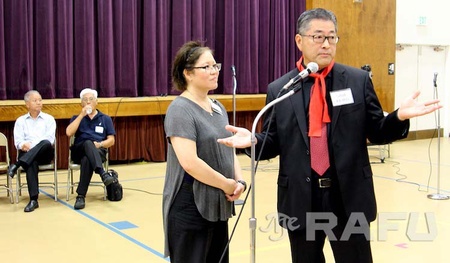
The committee continues to hope that the attorney general may be able to postpone the sale and require a public hearing. The next morning, David Hadley, representing the California Legislature’s 66th Assembly District, wrote a letter to Attorney General Harris, asking for just that. Before Hadley, the 66th District was represented by Japanese American politician Al Muratsuchi, who plans to run against Hadley in the next election.
Although Keiro could not answer all questions at the meeting, it promised to reply to each question submitted, and encouraged the audience to send future questions by email to planningforthefuture@keiro.org and by mail to Planning for the Future, Keiro Senior HealthCare, 325 S. Boyle Ave., Los Angeles, CA 90033.
* This article was originally published on The Rafu Shimpo on October 17, 2015.
© 2015 The Rafu Shimpo


